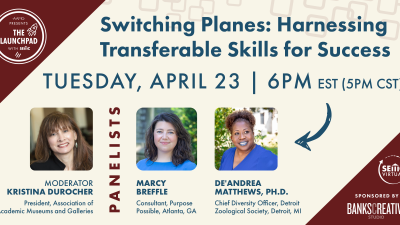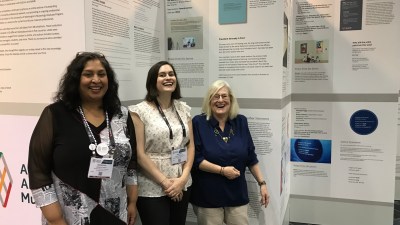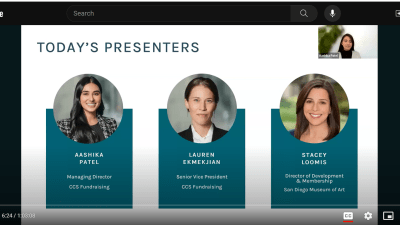I love telling people I am going to LA next week to forecast the future.
Not predict the future, mind you—forecast. There’s a big difference. Prediction implies certainty—“this is what is going to happen.” Forecasting is seeing a number of potential futures, assessing their likelihood and exploring their potential implications.
The California Association of Museums is celebrating its 30th anniversary, and thanks to a lovely invitation from Celeste DeWald, CAM’s executive director, next Tuesday I will help a group of museum and library practitioners, philanthropists, educators, politicians, community activists (and a lone game designer) forecast what the next 30 years will be like for California’s museums and their communities.
How do we go about this? Under the guidance of professional futurist Garry Golden of Oliver Kaizen, we will look at major trends shaping the state, factor in some potentially disruptive events, and then explore stories (scenarios) describing futures that might be created by these forces.
Skip over related stories to continue reading articleTurns out I am something of a pessimist, as futurists go. I find it a lot more fun to mess around inventing “Dark Futures” than “Bright Futures.” Garry scolds me to lighten up a little, but my Facebook posse concurs with me that the dystopian futures provide the most fodder for the imagination.
An example. What might happens as a result of the intersecting trends of:
• Increasing divide between rich and poor
• Increasing demographic diversity (racial/ethnic, cultural, immigrant/native, socioeconomic, educational attainment, etc.)
• People using the proliferation and fragmentation of news and entertainment to tailor their sources of information
• People self-segregating into homogeneous communities with common political/social views and values
• Technology increasing our ability to identify, track and monitor individuals in outdoor and public places
• Financial crises in state and local governments leading to downsizing of basic services such as education, transportation, trash collection, etc., not to mention support of cultural amenities
Maybe you get…Calibalkinization! (thank you, WriterGuy, for the brilliant title and the kernel of this scenario):
California continues to become more diverse—economically, racially, ethnically—and more polarized politically. The state fractures into subcultures along cultural fault lines in response to the stressors of ever-more dramatic inequality of distribution of wealth, tensions between long-time residents, new immigrants and temporary workers and political schisms.
As people are empowered to closely tailor their own sources of news, opinion and entertainment, political and cultural divisions widen. Continuing a trend first noted early in the century, people increasingly self-sort by where they live, work and spend their leisure time. As state funding declines, these communities are pushed towards self-sufficiency.
As formerly public areas (museums, libraries, parks) and public services (security, education, transportation), are cut or downsized, individuals and community groups step in to provide private alternatives.
Some communities self-segregate into “gated” enclaves along lines of race, ethnicity, immigrant and socioeconomic status and political affiliation. Other communities become defiantly diverse catch basins for those who either don’t or won’t fit inside the gates.
Location-based services become ubiquitous and most people expect to manage their identities and privacy while they are in the world. It is hard to enter a building or walk into a public area without being scanned and recognized (via facial recognition software) by someone’s surveillance equipment. In a sophisticated public relations move some ‘gated’ communities’ actually take down physical barriers, but install wireless perimeter that requires authorization of your profile and permission to enter the community as a guest. Those who are not identified are met by security patrol.
Communities build strong identities, cultivate local pride, engender high levels of trust between members and pride themselves on self-sufficiency. However they also erect barriers to movement and communication between enclaves, and compete to control resources such as water and energy. “Problem” people such as the indigent, mentally ill, homeless and jobless are aggressively deported. California residents have high levels of trust in community-based governance and authority, and exceedingly low trust in the state and federal governments.
So, what do you do with a story like this? You can, for example, explore:
–What trends and possible events support this scenario? Are there also trends that refute this story line?
–What are the implications for communities, local institutions and for museums in particular?
–What would California, its communities, local institutions and in particular, museums, do to respond?
–How does this scenario be extended? Where would the story proceed from here? Where does this future go?
We will ask the diverse group of working session participants to discuss these points for this and other scenarios.
From the content generated in this working session, CFM and CAM will produce “Museums as Community Catalysts: Shaping the Future of California”—a discussion and resource guide for the museum field. We will encourage museums to use the guide to stimulate conversations among staff, board and community leaders about what actions museums can take now to help their communities, the state and their institutions flourish in the future. Look for it later this summer on the CAM and CFM websites. Celeste and I will give a session on it at the Western Museums Association meeting next October.
If you are attending the AAM annual meeting next week, you can get a preview of the results of our forecasting at a session on Wednesday, May 26 at 9 a.m. (Convention Center room 502 B). Garry, Celeste and I will give an overview of the forecasts, present the recommendations drafted by participants and invite responses and dialogue. Hope to see you there!









Hi! Love this post. Glad I opened the link on twitter: I don't think you sold it well enough there 🙂 I love scenario planning (did my master in the mid '90s on internet scenario planning ah! ah! ah!) – keep on futuring! Love it!
cristina
Y'know it's funny. I can't remember who explained to me why the State of California is bankrupt, but these are essentially all the reasons s/he gave.
What it comes down to (s/he said) is districts. Each time a district became too large or diverse, they would fragment, resulting in smaller, completely homogeneous districts.
Politicians being what they are, they tend to be more concerned with getting re-elected than actually accomplishing anything in Sacramento–who *would* want to lose their job, right? especially in this economy!(or, we could be less cynical and say that politicians are obsessed with meeting the needs of their constituents, even at the expense or to the detriment of another politician's constituents)–and since there is such homogeneity within each district–without change over time–politicians must simply dig in their heels and always vote for and against the same things.
Sure, nothing is happening in Sacramento; the State Senate is perpetually in deadlock to the point where *every year* the budget is not passed on time and government workers have to go without pay for a little while, but the voters can look at their representatives' voting records and feel satisfied that their interests are being represented.
From an industry, resource, agriculture and population stance, California should be one of the richest states in the union. Politics, competing interests and increased segregation has destroyed that possibility. Yay.